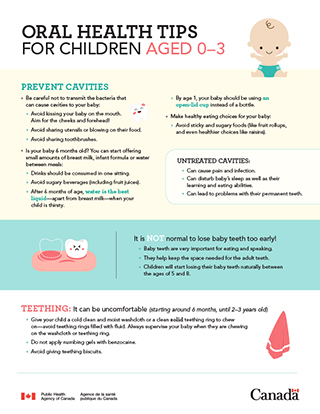Oral health tips for children aged 0–3

Download the alternative format
(PDF format, 210 KB, 1 pages)
Organization: Public Health Agency of Canada
Published: by authority of the Minister of Health, 2018
Cat.: HP35-95/2-2017E-PDF
ISBN: 978-0-660-23744-2
Pub.: 170272
Prevent cavities
Be careful not to transmit the bacteria that can cause cavities to your baby:
- Avoid kissing your baby on the mouth. Aim for the cheeks and forehead!
- Avoid sharing utensils or blowing on their food.
- Avoid sharing toothbrushes.
Is your baby 6 months old? You can start offering small amounts of breast milk, infant formula or water between meals:
- Drinks should be consumed in one sitting.
- Avoid sugary beverages (including fruit juices).
- After 6 months of age, water is the best liquid—apart from breast milk—when your child is thirsty.
- By age 1, your baby should be using an open-lid cup instead of a bottle.
Make healthy eating choices for your baby:
- Avoid sticky and sugary foods (like fruit rollups, and even healthier choices like raisins).
Untreated cavities:
- Can cause pain and infection.
- Can disturb baby’s sleep as well as their learning and eating abilities.
- Can lead to problems with their permanent teeth.
It is not normal to lose baby teeth too early!
- Baby teeth are very important for eating and speaking.
- They help keep the space needed for the adult teeth.
- Children will start losing their baby teeth naturally between the ages of 5 and 8.
Teething: It can be uncomfortable (starting around 6 months, until 2–3 years old)
- Give your child a cold clean and moist washcloth or a clean solid teething ring to chew on—avoid teething rings filled with fluid. Always supervise your baby when they are chewing on the washcloth or teething ring.
- Do not apply numbing gels with benzocaine.
- Avoid giving teething biscuits.
Take care of your baby’s mouth:
- After feeding your baby (with breast milk or with formula), use a clean, soft moist cloth to wipe your baby’s upper and lower gums.
- When your child’s first teeth come in, use a small soft-bristled toothbrush.
- Brush your child’s teeth, tongue and gums for 2 minutes, 2 times a day, but most importantly, before bedtime.
- For children using fluoridated toothpaste, teach your child to spit out the excess toothpaste and not swallow it. Do not rinse the mouth with water after brushing; this way, the fluoride in the toothpaste will continue to protect the teeth.
- Once your child’s teeth grow closer together and are touching, begin flossing every day.
- Routinely lift your child’s lip to check for anything on the teeth or in the mouth. If you see white chalky or brown spots on the teeth, consult your oral health professional or your public health office.
For more information, watch this helpful video on the "Lift the Lip" technique.
Visit an oral health professional within 6 months of your child’s first tooth coming in, or by age 1 to find out if your child is at risk of developing tooth decay.
Your child may be at risk of tooth decay if:
- You, someone at home, or a person in your child’s immediate circle has tooth decay.
- You live in a location that does not have fluoride in the tap water.
- Your child goes to bed with a bottle of anything but water.
- Your child usually snacks or drinks sugary beverages between meals.
- You can see plaque on your child’s teeth.
- You do not have easy access to oral health care services.
If your child is at risk of developing tooth decay, use a minimal amount (rice-sized grain) of fluoridated toothpaste.